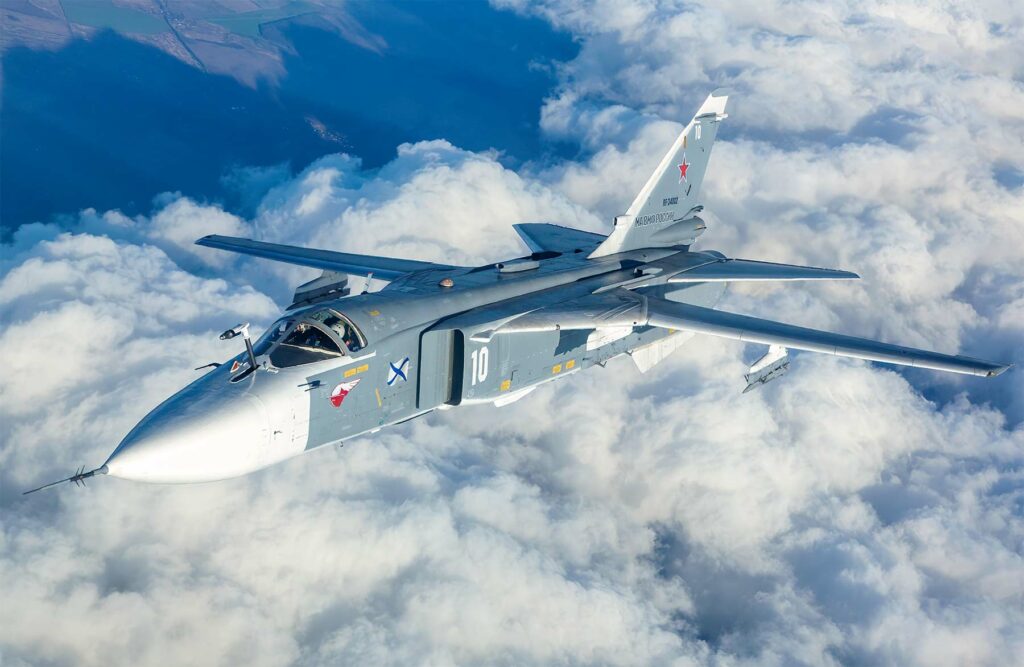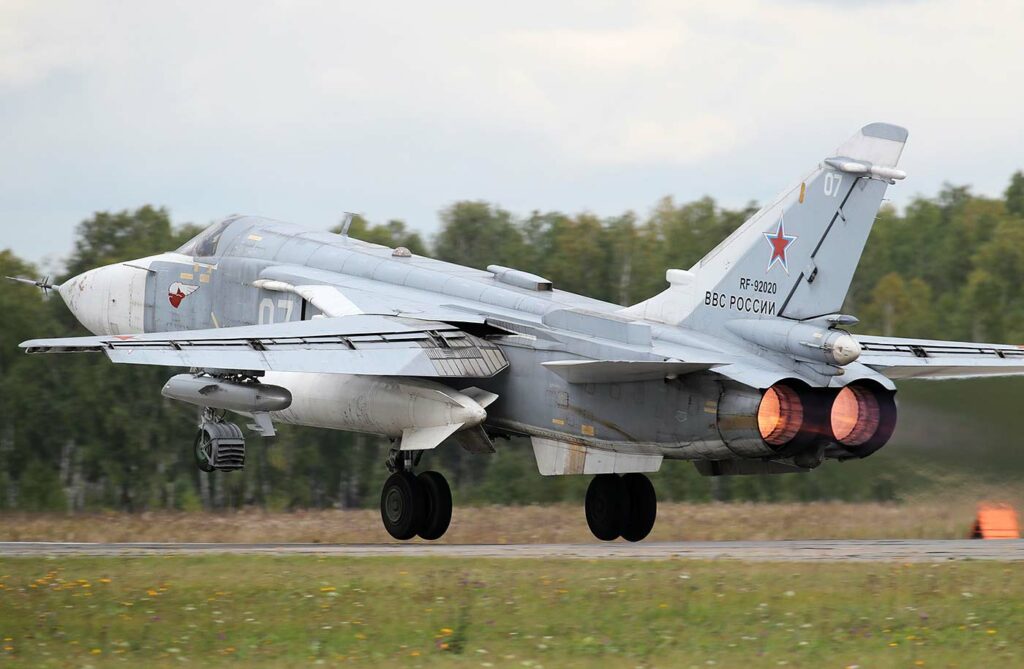All-weather, twin-engine supersonic tactical bomber, the Sukhoi Su-24, NATO codename “Fencer.”
In brief
The Sukhoi Su-24 “Fencer” is a robust, all-weather tactical bomber designed for deep penetration strikes under any weather conditions. Featuring a variable-sweep wing design, it boasts significant flexibility in flight profiles, enhancing its adaptability to various mission requirements. With dimensions of 73.5 feet in length and a wingspan ranging from 57.8 feet (spread) to 34.8 feet (swept), the Su-24 is powered by two Saturn/Lyulka AL-21F-3A turbojet engines, enabling speeds of up to Mach 1.35. Its operational range extends to 2,775 miles with external fuel tanks. The aircraft is equipped with advanced navigation and targeting systems, allowing it to deliver a wide range of munitions with precision. Its armament includes up to 8,000 kg of ordnance on nine hardpoints, making it a formidable platform for ground-attack missions.

History of the Development of the Sukhoi Su-24 (Fencer)
The development of the Sukhoi Su-24 “Fencer” began in the late 1960s as the Soviet Union sought to replace its aging fleet of first-generation jet bombers with a more capable, all-weather, and versatile strike aircraft. This need was driven by the evolving nature of global military strategy and the desire to have an aircraft capable of delivering precision strikes under all weather conditions, ensuring operational readiness in the face of NATO forces.
The Sukhoi Design Bureau was tasked with creating a bomber that could operate at high speeds, low altitudes, and in all weather conditions, leading to the innovative design of the Su-24. The program was officially launched in 1967, culminating in the aircraft’s first flight on July 2, 1970. The NATO designation “Fencer” reflects its role as a formidable adversary with capabilities thought to “fence in” opposing forces.
The Su-24 was a response to the need for a platform capable of carrying out deep penetration strikes, reconnaissance, and electronic warfare operations across Europe and Asia. It represented a significant technological leap, incorporating a variable-sweep wing for optimal performance across a wide range of speeds and altitudes, a feature inspired by the success of similar designs in Western aircraft.
Design of the Sukhoi Su-24 (Fencer)
The Sukhoi Su-24 features a distinctive variable-sweep wing design, allowing it to perform at a wide range of speeds and operational altitudes. This adaptability makes it suited for low-level, high-speed penetration strikes, as well as more conservative, fuel-efficient flight profiles. The aircraft’s length of 22.4 meters (73.5 feet) and variable wingspan, from 17.64 meters (57.8 feet) at its widest to 10.37 meters (34.8 feet) when fully swept, underline its versatility.
Powered by two Saturn/Lyulka AL-21F-3A engines, the Su-24 delivers a thrust that propels it to speeds up to Mach 1.35. It has a maximum takeoff weight of approximately 39,700 kg (87,522 pounds), demonstrating its capability to carry a substantial payload. The aircraft is equipped with an internal navigation and targeting system that integrates with external pods for laser-guided and TV-guided bombs, enabling precision strikes in adverse weather conditions.
One of the design challenges was managing the complexity and weight of the variable-sweep wing mechanism and ensuring the aircraft could maintain high performance with a full weapons load. Despite these challenges, the Su-24’s design provides a balanced combination of speed, range, and payload capacity, contributing to its success as a tactical bomber.
Performance of the Sukhoi Su-24 (Fencer)
The performance of the Su-24 is characterized by its high-speed, low-altitude penetration capability, making it a potent tool for striking deep into enemy territory. With a maximum speed of over Mach 1.35 and a range of up to 2,775 miles (with external fuel tanks), it can swiftly reach and engage targets far from its bases. The aircraft’s ceiling is above 36,000 feet, allowing it to operate above most anti-aircraft systems when necessary.
Compared to its contemporaries, such as the American F-111 Aardvark, the Su-24 holds its ground in terms of speed, range, and payload capacity. Its variable-sweep wing technology allows for an optimized performance across a broad spectrum of mission profiles, providing the Soviet and later Russian air forces with a versatile and effective strike capability.
Variants of the Sukhoi Su-24 (Fencer)
The Su-24 has been produced in several variants, each designed to enhance certain aspects of the aircraft’s capabilities. The initial production model, the Su-24M (“Fencer-D”), introduced improvements in avionics and weaponry, significantly enhancing its operational effectiveness. The Su-24MR (“Fencer-E”) is a dedicated tactical reconnaissance variant, equipped with sophisticated sensors and cameras for deep reconnaissance missions. Another variant, the Su-24MP (“Fencer-F”), is specialized in electronic signals intelligence, featuring equipment for intercepting and jamming enemy communications. Each variant underscores the platform’s adaptability to a range of military requirements.

Military Use and Combat of the Sukhoi Su-24 (Fencer)
The Su-24 has seen extensive military use in various conflicts, showcasing its capabilities as a versatile strike aircraft. Its armament includes a wide range of precision-guided munitions, free-fall bombs, and rockets, making it adaptable to different combat scenarios. The aircraft has participated in operations from the Soviet invasion of Afghanistan to more recent conflicts in Syria, where it has been used for ground-attack missions, close air support, and strategic bombing campaigns.
During the Soviet invasion of Afghanistan, the Su-24 demonstrated its operational value in a rugged terrain that presented unique challenges for air operations. Its ability to fly at low altitudes at high speeds allowed it to evade radar detection and deliver strikes with surprising speed and ferocity, showcasing its design’s suitability for penetrating enemy defenses.
In the more recent context of the Syrian Civil War, the Su-24 has been instrumental in conducting ground-attack missions, supporting Syrian government forces against various opposition groups. Its role in close air support has been particularly noted, providing critical firepower to support ground operations and impact the strategic balance. Moreover, the aircraft’s use in strategic bombing campaigns has highlighted its continued relevance in state-on-state conflicts, where deep strikes against enemy infrastructure and military targets can shape the course of operations.
Its operational success can be attributed to its robust design, capable of withstanding significant damage while remaining operational. The Su-24’s versatility was demonstrated in conflicts where it operated alongside and against aircraft like the American F-16 and F/A-18, proving itself as a formidable opponent due to its low-level penetration capabilities and electronic warfare systems.
The Su-24 has been exported to several countries, enhancing the strike capabilities of air forces in the Middle East, North Africa, and the CIS. Although some operators have begun to retire the Su-24 in favor of newer aircraft, it remains in service in several countries, including Russia, where it continues to receive upgrades, extending its operational life and relevance on the modern battlefield.
–
The Sukhoi Su-24 “Fencer” stands as a significant contribution to 20th-century military aviation, embodying the characteristics of an effective tactical bomber capable of operating under all weather conditions. Its development and operational history highlight its adaptability, resilience, and the strategic value it has provided to its operators over the decades. As it continues to serve, the Su-24 remains a testament to the enduring utility of well-designed military aircraft in modern warfare.
Back to the Bombers section.